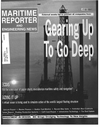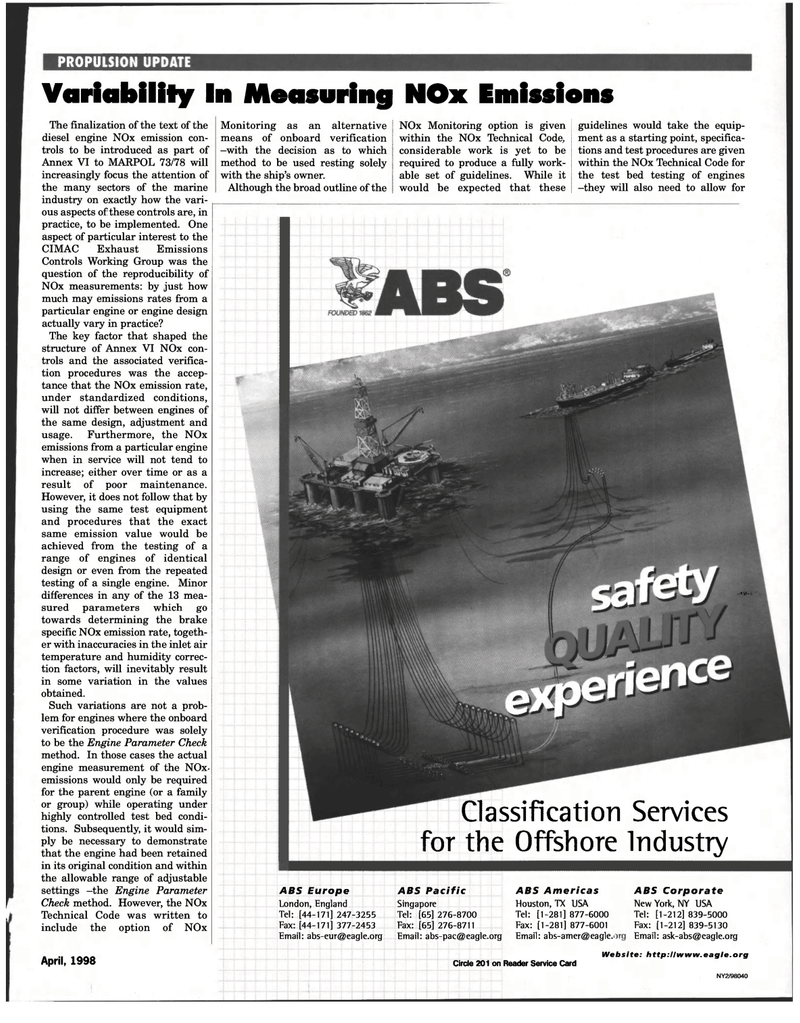
Page 81: of Maritime Reporter Magazine (April 1998)
Read this page in Pdf, Flash or Html5 edition of April 1998 Maritime Reporter Magazine
Variability In Measuring NOx Emissions
PROPU
The finalization of the text of the diesel engine NOx emission con- trols to be introduced as part of
Annex VI to MARPOL 73/78 will increasingly focus the attention of the many sectors of the marine industry on exactly how the vari- ous aspects of these controls are, in practice, to be implemented. One aspect of particular interest to the
CIMAC Exhaust Emissions
Controls Working Group was the question of the reproducibility of
NOx measurements: by just how much may emissions rates from a particular engine or engine design actually vary in practice?
The key factor that shaped the structure of Annex VI NOx con- trols and the associated verifica- tion procedures was the accep- tance that the NOx emission rate, under standardized conditions, will not differ between engines of the same design, adjustment and usage. Furthermore, the NOx emissions from a particular engine when in service will not tend to increase; either over time or as a result of poor maintenance.
However, it does not follow that by using the same test equipment and procedures that the exact same emission value would be achieved from the testing of a range of engines of identical design or even from the repeated testing of a single engine. Minor differences in any of the 13 mea- sured parameters which go towards determining the brake specific NOx emission rate, togeth- er with inaccuracies in the inlet air temperature and humidity correc- tion factors, will inevitably result in some variation in the values obtained.
Such variations are not a prob- lem for engines where the onboard verification procedure was solely to be the Engine Parameter Check method. In those cases the actual engine measurement of the NOx- emissions would only be required for the parent engine (or a family or group) while operating under highly controlled test bed condi- tions. Subsequently, it would sim- ply be necessary to demonstrate that the engine had been retained in its original condition and within the allowable range of adjustable settings -the Engine Parameter
Check method. However, the NOx
Technical Code was written to include the option of NOx
April, 1998
Monitoring as an alternative means of onboard verification -with the decision as to which method to be used resting solely with the ship's owner.
Although the broad outline of the
NOx Monitoring option is given within the NOx Technical Code, considerable work is yet to be required to produce a fully work- able set of guidelines. While it would be expected that these guidelines would take the equip- ment as a starting point, specifica- tions and test procedures are given within the NOx Technical Code for the test bed testing of engines -they will also need to allow for
ABS Europe ABS Pacific
London, England
Tel: [44-171] 247-3255
Fax: [44-171] 377-2453
Email: [email protected]
Singapore
Tel: [65] 276-8700
Fax: [65] 276-8711
Email: [email protected] -rv-i-'.:
Classification Services for the Offshore Industry
ABS Americas
Houston, TX USA
Tel: [1-281] 877-6000
Fax: [1-281] 877-6001
Email: abs-amer@eagle.<
ABS Corporate
New York, NY USA
Tel: [1-212] 839-5000
Fax: [1-212] 839-5130
Email: [email protected]
Circle 201 on Reader Service Card
Website: http:llwww.eagle.org
NY2/98040

 80
80

 82
82
